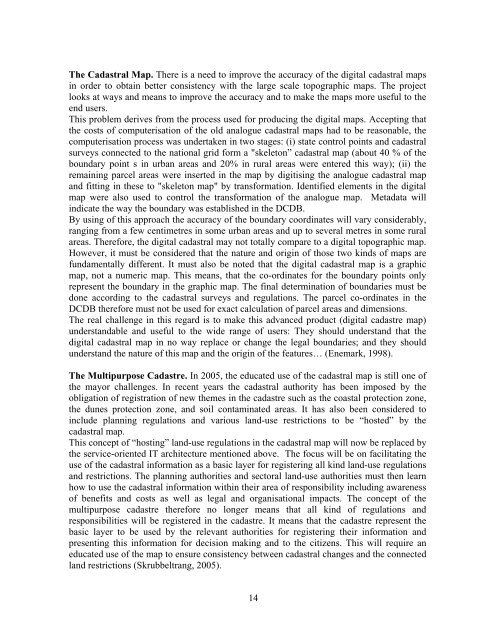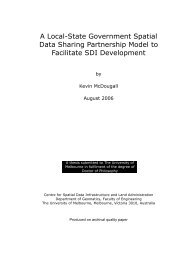The Danish Way - Centre for Spatial Data Infrastructures and Land ...
The Danish Way - Centre for Spatial Data Infrastructures and Land ...
The Danish Way - Centre for Spatial Data Infrastructures and Land ...
You also want an ePaper? Increase the reach of your titles
YUMPU automatically turns print PDFs into web optimized ePapers that Google loves.
<strong>The</strong> Cadastral Map. <strong>The</strong>re is a need to improve the accuracy of the digital cadastral maps<br />
in order to obtain better consistency with the large scale topographic maps. <strong>The</strong> project<br />
looks at ways <strong>and</strong> means to improve the accuracy <strong>and</strong> to make the maps more useful to the<br />
end users.<br />
This problem derives from the process used <strong>for</strong> producing the digital maps. Accepting that<br />
the costs of computerisation of the old analogue cadastral maps had to be reasonable, the<br />
computerisation process was undertaken in two stages: (i) state control points <strong>and</strong> cadastral<br />
surveys connected to the national grid <strong>for</strong>m a "skeleton” cadastral map (about 40 % of the<br />
boundary point s in urban areas <strong>and</strong> 20% in rural areas were entered this way); (ii) the<br />
remaining parcel areas were inserted in the map by digitising the analogue cadastral map<br />
<strong>and</strong> fitting in these to "skeleton map" by trans<strong>for</strong>mation. Identified elements in the digital<br />
map were also used to control the trans<strong>for</strong>mation of the analogue map. Metadata will<br />
indicate the way the boundary was established in the DCDB.<br />
By using of this approach the accuracy of the boundary coordinates will vary considerably,<br />
ranging from a few centimetres in some urban areas <strong>and</strong> up to several metres in some rural<br />
areas. <strong>The</strong>re<strong>for</strong>e, the digital cadastral may not totally compare to a digital topographic map.<br />
However, it must be considered that the nature <strong>and</strong> origin of those two kinds of maps are<br />
fundamentally different. It must also be noted that the digital cadastral map is a graphic<br />
map, not a numeric map. This means, that the co-ordinates <strong>for</strong> the boundary points only<br />
represent the boundary in the graphic map. <strong>The</strong> final determination of boundaries must be<br />
done according to the cadastral surveys <strong>and</strong> regulations. <strong>The</strong> parcel co-ordinates in the<br />
DCDB there<strong>for</strong>e must not be used <strong>for</strong> exact calculation of parcel areas <strong>and</strong> dimensions.<br />
<strong>The</strong> real challenge in this regard is to make this advanced product (digital cadastre map)<br />
underst<strong>and</strong>able <strong>and</strong> useful to the wide range of users: <strong>The</strong>y should underst<strong>and</strong> that the<br />
digital cadastral map in no way replace or change the legal boundaries; <strong>and</strong> they should<br />
underst<strong>and</strong> the nature of this map <strong>and</strong> the origin of the features… (Enemark, 1998).<br />
<strong>The</strong> Multipurpose Cadastre. In 2005, the educated use of the cadastral map is still one of<br />
the mayor challenges. In recent years the cadastral authority has been imposed by the<br />
obligation of registration of new themes in the cadastre such as the coastal protection zone,<br />
the dunes protection zone, <strong>and</strong> soil contaminated areas. It has also been considered to<br />
include planning regulations <strong>and</strong> various l<strong>and</strong>-use restrictions to be “hosted” by the<br />
cadastral map.<br />
This concept of “hosting” l<strong>and</strong>-use regulations in the cadastral map will now be replaced by<br />
the service-oriented IT architecture mentioned above. <strong>The</strong> focus will be on facilitating the<br />
use of the cadastral in<strong>for</strong>mation as a basic layer <strong>for</strong> registering all kind l<strong>and</strong>-use regulations<br />
<strong>and</strong> restrictions. <strong>The</strong> planning authorities <strong>and</strong> sectoral l<strong>and</strong>-use authorities must then learn<br />
how to use the cadastral in<strong>for</strong>mation within their area of responsibility including awareness<br />
of benefits <strong>and</strong> costs as well as legal <strong>and</strong> organisational impacts. <strong>The</strong> concept of the<br />
multipurpose cadastre there<strong>for</strong>e no longer means that all kind of regulations <strong>and</strong><br />
responsibilities will be registered in the cadastre. It means that the cadastre represent the<br />
basic layer to be used by the relevant authorities <strong>for</strong> registering their in<strong>for</strong>mation <strong>and</strong><br />
presenting this in<strong>for</strong>mation <strong>for</strong> decision making <strong>and</strong> to the citizens. This will require an<br />
educated use of the map to ensure consistency between cadastral changes <strong>and</strong> the connected<br />
l<strong>and</strong> restrictions (Skrubbeltrang, 2005).<br />
14







